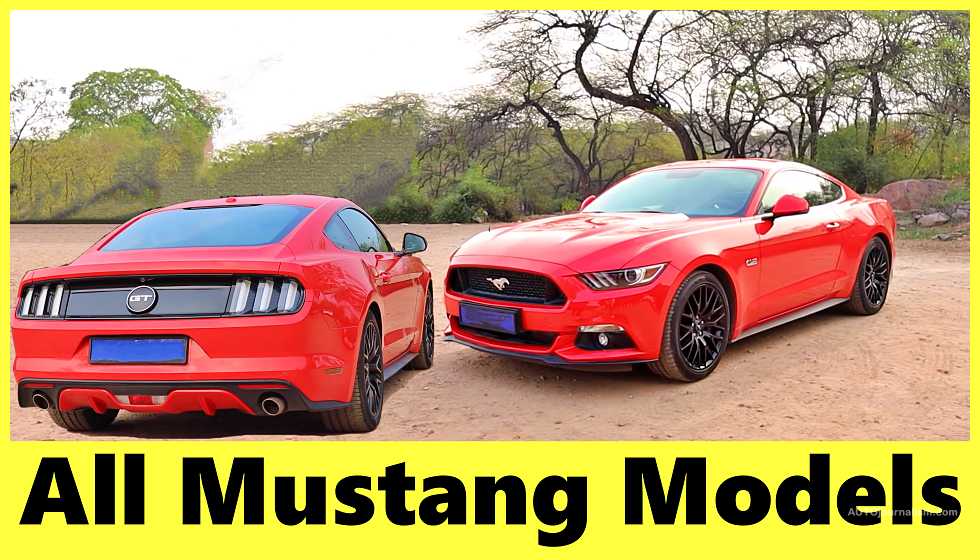All Mustang Models with pictures
Table of Contents
In this article, we will give you full info related to All Mustang Models Evolution. Everyone loves cars, but old cars have their own value. Everyone loves classic, vintage, and popular models from the past. Even the younger generation prefers older models, and the Ford Mustang has its own fan base on the planet. So, let’s know more about Mustang’s Evolution.
List of All Mustang Models with pictures
To understand how the first Mustang evolved from Old Mustang to New Mustang, we must first go back to the 1960s, when Ford was aiming to build a car for baby boomers that was different from the huge sedans and family cars their parents were driving.
1. FORD Mustang 1964 – 1966

(First Generation MUSTANG) So, in 1964, The first Mustang was released by Ford. It was a small automobile, but it was sleek and attractive, and it had a lot of power for its size, even if it wasn’t the most powerful car on the market. Ford’s top-of-the-line model had a 4.7-liter V8 engine that produced 271 horsepower and could accelerate from zero to 60 mph in seven and a half seconds. While it wasn’t the fastest car on the market, Ford quickly realized that those were not its limits. Ford saw the mustang’s potential as a true race car right away.
So they hired racing engineer Carol Shelby to make it happen. These aren’t just words; they’re facts. Shelby gave them not one, but two street-legal race cars, the gt350 and gt500. The gt500 received the same powerful v8 engine as the Lamar-winning gt40. By the end of the 1960s, this mustang on steroids had adjustable shocks, better wheels, a larger anti-roll bar, and best of all, a starring part alongside Nicholas cage, and it was gone in 60 seconds.
The original Mustang debuted in 1964, and it was, without a doubt, the first pony car. It began as a concept for a personal luxury coupe under the “Allegro” project. After seeing wild mustangs in Nevada, one of the designers, Philip T. Clark, came up with the name Mustang. He created the emblem and showed it to Lee Iaccoca, who was enthusiastic about the name and the notion of a unique badge for the car.
The Mustang was designed by Lee Iaccoca to be a personal automobile. It had a pushed-out grille and two circular headlamps. The Mustang sparked people’s imaginations with its tall hood, 2+2 cabin, and short deck.
Ford fitted a variety of engines under the hood, starting with a 100-horsepower inline-six mated to a 3-speed manual transmission. After the car was hailed by the media and customers, the American automaker introduced two more V8 engines.
2. FORD Mustang 1966 – 1968

When there were no computer-aided design processes, the engineering team and designers worked around the clock to complete the project in just 18 months. Since it was the first car in a new segment, the outcome exceeded expectations.
The Mustang sedan was designed by Joe Oros and had two doors and standard three-box bodywork. Then he built the fastback in secret, had it cast in fiberglass, and showed it to Iacocca. The legend was born when the Big Chief accepted. Joe Oros, a European immigrant, had a unique perspective. He wanted the automobile to have a distinctive front fascia and posture. The Mustang badge, not the blue oval, is displayed on the grille in this manner. The circular headlamps were set slightly further back than the grille. The greenhouse featured a slanted rear window and strong B-pillars with air vents, which set it distinct from the conventional coupe form.
The Mustang stood out from other American cars on the road because of its sculpted side panels. Ford added a special logo to the fenders behind the front wheels for the 1965 model.
3. FORD Mustang 1970 – 1973
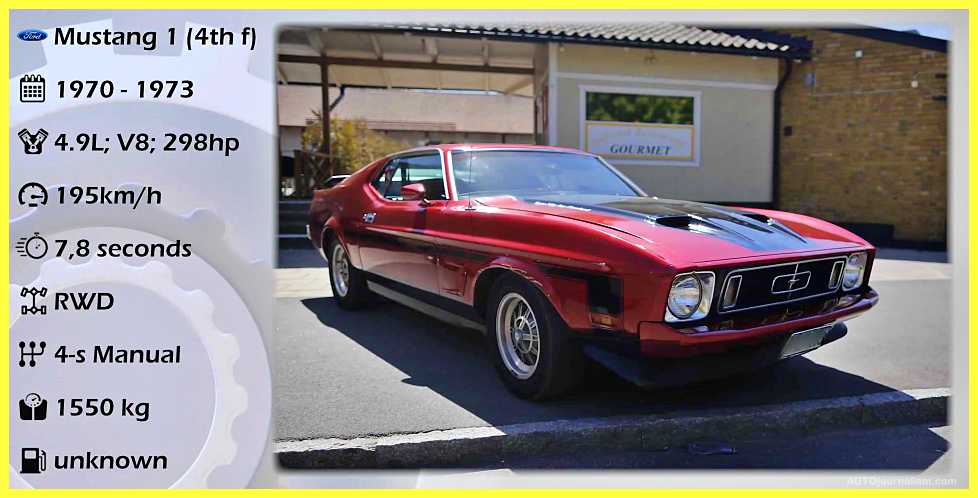
(Second Generation MUSTANG) The famous cobra jet engine was given to the Shelby mustang now being built in Ford’s factory. The cobra jet was based on the previous engine, the gt500s, but it was upgraded with an enormous valve head, a bigger carburetor, and a special performance air cleaner. The cobra jet could produce over 400 horsepower, but Ford reported it at 335 so it could qualify for easier-to-win classes at Dragons. Ford’s Mustang was a huge success; 22 000 automobiles were sold on the first day, and a million were sold in two years.
However, with competition from chevy’s Camaro and Pontiac’s Firebird, Ford needed bigger and bigger engines to compete, so the mustang grew. However, when stricter fuel emission laws forced automakers to make lower power output, the company was left with a mustang that was now bloated and boring, and sales tanked, forcing Ford to rethink its strategy.
The magnificent period of muscle cars was at its pinnacle, and the midnight races and quarter-mile times were at the heart of all marketing plans. All carmakers recognized that a strong vehicle would sell more than a less powerful vehicle, and the image of a “daytime cruiser and night-time racer” sold better than any other, especially in the coupe sector.
Ford designers conceived a redesigned front fascia with two additional headlamps built into the outer side of the grille. Aside from the running horse logo, the Mustang now had a nighttime distinctive image. The fastback variant has two air vents on the rear quarter panels, giving it a meaner appearance. Above them, all was the Boss 429, which boasted a 375 horsepower engine.
The dashboard was significantly redesigned on the inside and included a four-dial instrument cluster. The dashboard still appeared to be two separate components connected by a central stack. It had conventional sport-bucket seats in the front, while the rear bench was easy to detach.
Ford offered three engine options for the drivetrain, as well as customized models such as the Mach 1, Boss 302, and Boss 429. The latter was a street-legal drag racer powered by a Nascar engine.
4. FORD Mustang 1973 – 1978
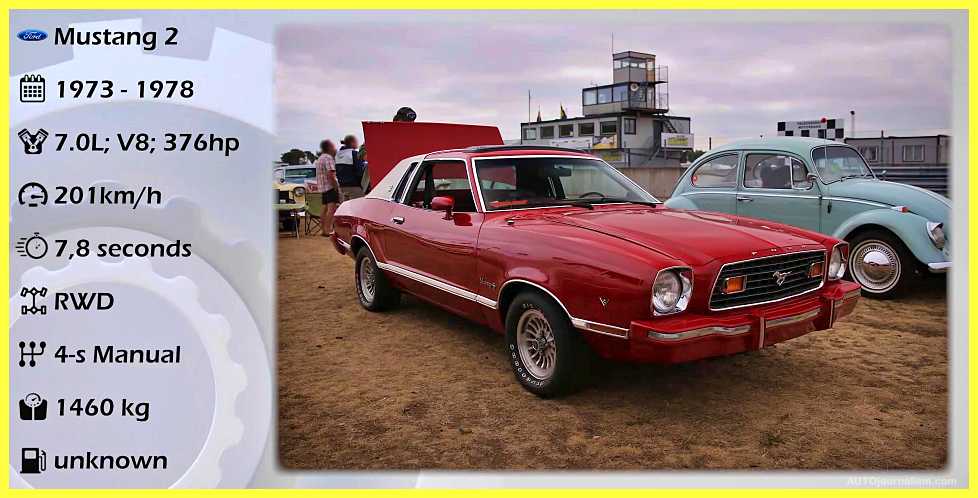
(Second Generation MUSTANG) By the 1970s, huge automobiles had lost their luster, and Americans had fallen in love with European sports cars and Japanese compacts. Ford saw the issue and responded with the mustang, which was 500 pounds lighter and 20 inches shorter than the previous model, but it also threw the Mustang’s reputation for speed out the window. Its tiny standard engine produced as little as 88 horsepower, and its only optional engine was a v6 that barely produced a hundred. The top-level mustang hit 60 mph in 12 seconds, but Americans weren’t looking for horsepower, and oil prices had skyrocketed in 1973, the economy was tanking, and consumers needed to save money.
5. FORD Mustang 1979 – 1982

(Third Generation MUSTANG) Ford responded with a 5 liter v8 for the mustang, but it was a far cry from the performance mustangs were producing a few years earlier at 134 horses it barely got a top speed of 100 miles per hour it was time for the mustang to go back to its roots at 134 horses it barely got a top speed of 100 miles per hour it was time for the mustang to go back to its roots at 134 horses it barely got a top speed of 100 miles per hour it was time
6. FORD Mustang 1983 – 1986
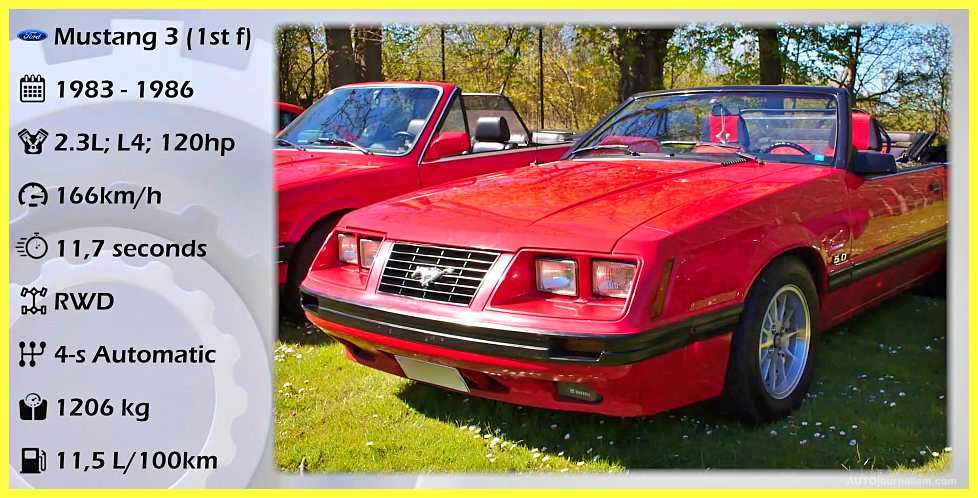
(Third Generation MUSTANG) The fox body mustang, one of Ford’s most iconic automobiles to date, was the company’s response. Because of its unibody structure, flexible chassis, and large engine bay, Ford had been employing the fox platform for anything from tiny sedans to station wagons. The Mustang was an instant hit when it was added to the roster of vehicles, and its versatility has kept the fox body mustang popular in cartoons even now.
7. FORD Mustang 1986 – 1993
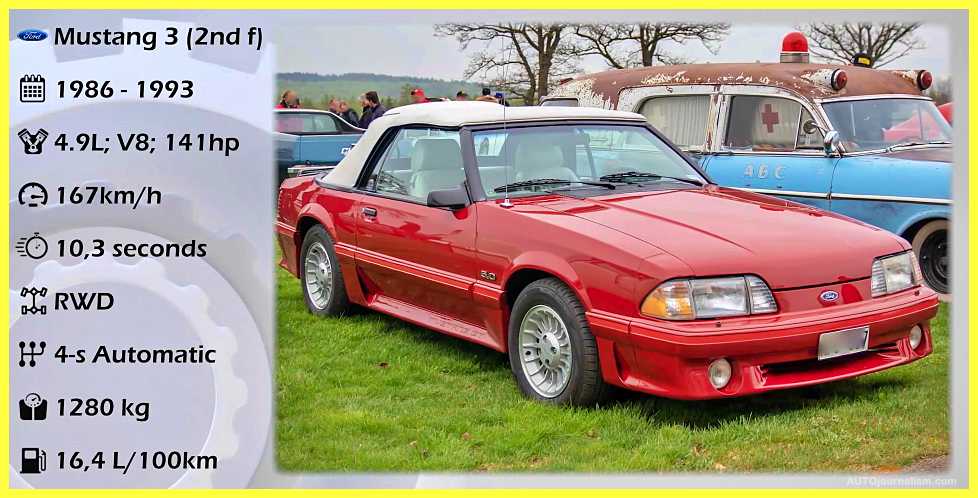
(Third Generation MUSTANG) Ford’s new pony car was larger and broader than the mustang 2, but it weighed 200 pounds less, improving gas efficiency and lowering drag. However, the muscle car era had come to an end, the country was in an economic slump, and strict fuel pollution standards were in place. Another oil crisis in 1979 led Ford to downsize its top-of-the-line v8 engine, giving the mustang a 0-60 time of 10.8 seconds. Ford tried to appease speed freaks and the EPA by introducing mustang’s first-ever turbocharged engine.
The Mustang’s second generation was on its way out, and a replacement was in the works. But, because it was based on the controversial Pinto platform, Ford still had to sell the car, even if it was not well received by its fan base. The King Cobra version of the Mustang 1978 set it apart from the rest of the lineup.
The King Cobra had some distinct design aspects while looking more like an extended Pinto than a fastback Mustang. It was also available in a Targa body form, which was regarded as superior to the rag-top models. Its slanted back end and a tailgate that opened the trunk elicited mixed reactions from its loyal customers. The hood, with its dome in the center, was the most attractive element of the car.
The car’s interior included sport-bucket seats for the front passengers and a bench that could only be used to store a sandwich. Ford developed the automobile to be a commuting car rather than a long-distance cruiser. Its wheelbase was far too short for such an application.
The 5.0-liter engine under the hood was one of the lowest-power 5.0-liter engines available at the time. The V8 engine produced three fewer horsepower than the European BMW 323, which had a 2.3-liter engine. Ford, on the other hand, tried to persuade customers that the automobile was sporty and could handle better than its rivals.
8. FORD Mustang 1993 – 1998

(Fourth Generation MUSTANG) It was a tiny little four-cylinder engine dubbed the lima that Ford hoped would be a performance level engine, but it frequently overheated and forward engineers couldn’t the iron out the bugs with turbocharging before his invention of fuel injection altered everything. Carburetors mixed fuel and air for combustion, but on a four-cylinder engine, some cylinders were further apart than others, making it difficult to ensure the proper fuel to air mixture. With fuel ejection, high air pressure is used to deliver fuel from the gas tank directly into the engine’s cylinders in precise bursts.
There is no longer a need for a carburetor, but the mixture that occurs right inside the engine cylinders makes the engine more reliable, fuel-efficient and emits fewer toxic gases.
9. FORD Mustang 1998 – 2004

(Fourth Generation MUSTANG) It had a new jelly bean shape with hints of the original mustang, particularly in the interior. In 1993, Ford gathered some of its top engineers and assigned them one mission: to outrun the world’s most extreme speed freaks. They were dubbed the special vehicle team.
They also gave the world the cobra as a gift. We receive the mustang’s first-ever independent rear suspension on the SVT the Cobra model, which means each tire on the back axle could move independently of one another, allowing them to stay rooted even in the tightest turns, although the fox body still had the advantage in a drag race.
The new Mustang was significantly better on the track for 2003, when Ford put the same supercharger used on the Ford f-150 Lightning pickup truck to the cobra SVT’s improved engine, and it accelerated from zero to 60 in 4.5 seconds. Ford’s previous pony car was once again a street-legal race vehicle, and the mustang’s main competition, the Chevrolet Camaro, couldn’t keep up, with sales plummeting and the Chevrolet access sports car mustang now in a class of its own.
Ford pioneered the cutting-edge design trend in the automotive industry. With the addition of new design components, the updated Mustang took on a more manly appearance. Unfortunately, the solid rear axle, which was much out of date for a 1999 sports vehicle, was retained by the American automaker.
While the bodywork on the 1994 Mustang lacked any straight lines, the 1999 model was almost the polar opposite. An expensive fake air intake on the rear fenders, as well as angular headlights and taillights, sharp edges on the hood and sides, and an extravagant fake air intake on the front fenders. However, some may notice the greenhouse design and, in the case of the Cobra models, the hood dome.
The rounded lines were still present on the inside, with a wave-like dashboard that resembled the original 1964 12 Mustang panel, but with a deep center stack that stretched to the center console. The front bucket seats were designed for comfort, although a set with more bolstering was available as an option. There was just enough room in the rear for two persons, but there was no headroom. Every jolt in the road may have caused brain damage because the rear axle was nowhere near the comfort zone.
10. FORD Mustang 2004 – 2008

The mustang eventually got its own platform with the fifth generation, and for the first time in 30 years, the mustang approximated the iconic design of the original by 2011.
Jeep, Ford Mustang, and Chevrolet Corvette are just a few of the most iconic American cars in automotive history. While the Jeep was the only true off-road contender in the United States, the other two gained their titles on drag strips and in numerous races around recognized courses. While the Corvette matured into a supercar, the Mustang was a more inexpensive sports vehicle that was designed to be a comfortable daily driver and, in some variants, a serious competitor on handling courses.
The first pony car was known for its rear-cab design since its launch in 1964. Its renown faded over time, but the 2004 model may be considered a true reincarnation of the famous coupe. It, like its predecessor, was no longer available in a three-box format.
The circular headlights were inspired by the original form and accepted by the design team. The 2005 Mustang has a flat, vertical front fascia with a black grille and separate headlamp casings, just like the original. Fog lights were put in the grille as an option. The roofline followed the same line as the original fastback variant from the late 1960s from the sides. The three vertical taillights in the back followed the same retro-design layout.
Inside, the design was more modern than retro-inspired, but the chromed rings around the tachometer and speedometer remained. Ford equipped the vehicle with modern bucket seats with headrests and a spacious center console with cupholders. There was a bench in the back for passengers who weren’t too tall. The Mustang was initially available with only two V8 engines: a 4.0-liter and a 4.6-liter.
11. FORD Mustang 2008 – 2013
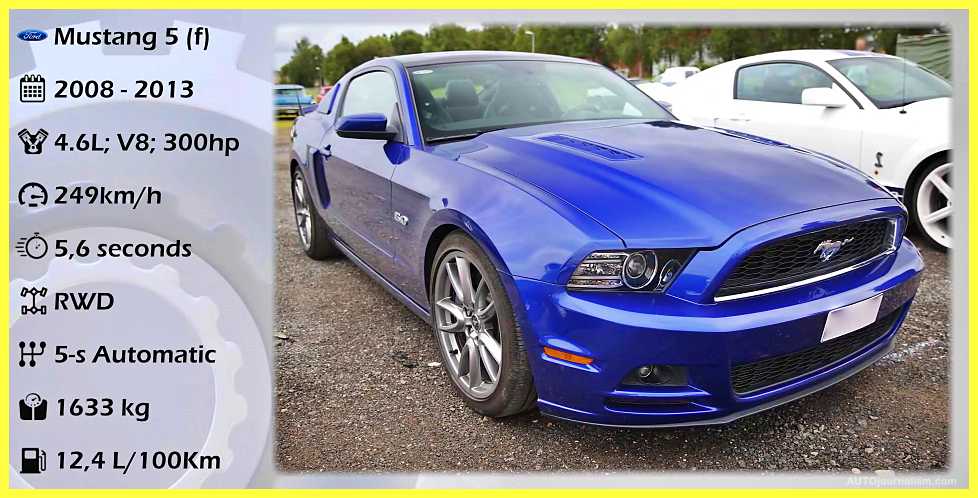
(Fifth Generation MUSTANG)Ford would add a brand new v8 engine known as the coyote to it, which was rated at around 412 horsepower and cost around $30,000. With the coyote under the hood, the mustang had a faster Nurburgring time than BMW’s 60 000 m3. In 2007, Ford and Carroll Shelby would resurrect their partnership and produce the first GT500 in almost 40 years.
Although the Mustang’s strong outward design was favorably received, it lacked sophisticated handling and top-notch interior quality when compared to competitors such as the Mazda RX-8 and Nissan 350Z.
The 2009 Mustang was offered in four trim levels: V6 Deluxe, V6 Premium, GT Deluxe, and GT Premium, and was available as a coupe or convertible. The V6 Deluxe had 16-inch alloy wheels, cruise control, air conditioning, and keyless entry as standard equipment, while the V6 Premium featured a power driver seat and a new audio system.
The GT Deluxe package included larger 17-inch alloy wheels, a rear spoiler, fog lamps, and sports seats.
The GT Luxury brought leather upholstery and a premium audio system to the top of the line.
18-inch alloy wheels, xenon headlights, remote ignition, ambient lighting, and a new glass roof were available as stand-alone options.
The Mustang has standard front-seat side airbags and 4-wheel disc brakes for safety. Antilock brakes and a traction control system, which were standard on the GT trim level, were available as options.
With harsh plastics all throughout, the inside appeared a little antiquated for 2009, and the quality of materials made the car feel cheap.
The Mustang could fit up to four people in the back, although the space was limited. The trunk was quite large.
12. FORD Mustang 2013 – 2017

(Sixth Generation MUSTANG) by 2013 they are cranking out the most powerful American v8 you can find on the road but the independent rear axle that was so well received was ditched to cut costs, consumers didn’t care sales skyrocketed but two things were coming that we’re going to ruin the party
the 2008 recession and the return of the Camaro chevy took note of the public’s reaction to the new mustang and it decided to revive its pony car with one two hour and 23-minute commercial called transformers chevy took back the market the last five years of the fifth-generation Mustang was the worst five years of the mustang’s sale history the Camaro was America’s favorite pony car.
The Mustang’s origins may be traced back to the 1960s, when John Oros, a designer whose parents came from Transilvania (Romania), created the concept and won an internal design competition with his team. The first final model, designated as the 1964 12 models, rolled out of the plant in 1964. After that, it was all history.
Mr. Oros died in 2012, but his design concept was carried over into the 2014 edition, which has a retro-style aspect. The original concept was to create “a car that both the ladies and the men would adore.” The car’s design was highlighted by its tall hood, slanted cabin, and aggressive appearance.
Car fans preferred the fastback form of the original Mustang. Only a convertible and a fastback coupe were available for the 2014 coupe. A tiny rear spoiler was added to the long, sloping roof. The original ponytail was preserved and used. On the 1964 Mustang, the three angled lights were present on the DRL upfront inside the headlights and on the rear taillights.
13. FORD Mustang 2017 MODEL
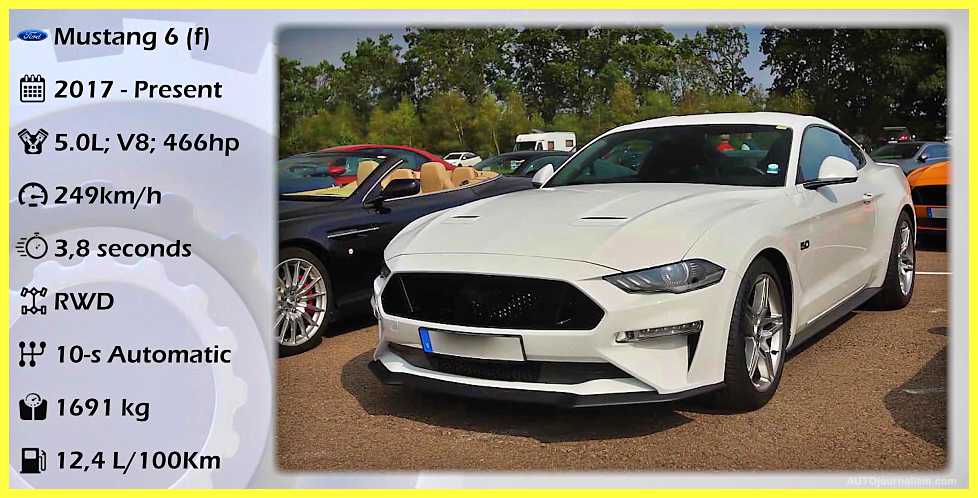
The classic styling harkens back to the original 1964 Mustang. The car’s stylish design included three vertical taillights, a fastback form, and a tall hood. The car’s front end didn’t have the original model’s circular headlamps, but the designers did a better job than that. The silver galloping horse, which harkens back to the car’s beginnings, matched the flat hexagonal grille.
Inside, there were four seats, however, the room was limited due to the greenhouse form and front seats. Ford fitted a SYNC 3 infotainment system for the driver, which could be synced with a smartphone. As another touch of antique design, the toggle switches on the central panel looked great.
The Ford Mustang was available with three engine options: a 4-cylinder turbocharged, a 3.7-liter V6, and a 5.0-liter V8. In Europe, the four-pot and the V8 were available, but the V6 was not. A 6-speed manual transmission was standard, although a 6-speed automatic was also available. The good news is that the 2017 Mustang only came with four-wheel independent suspension, which made it better in corners than prior models, which relied on a live axle to move the vehicle.
14. FORD Mustang

The exterior paint hue of the Bullitt Mustang may be clearly distinguished from the GT and EcoBoost models. Customers could only select between two colors: green (not just any green; see the movie!) and black. The chromed grille, 5-spoke alloy wheels, and Brembo calipers were among the other aesthetic modifications.
The Mustang badge was replaced by the Bullitt logo and was not visible outside or inside the Bullitt (of course).
The Bullitt’s cabin was comparable to the Mustang’s previous models, with the exception of a cue ball shifter and an aluminum bezel. Recaro seats are an option for users.
The car’s driving modes, as well as the steering, suspension, and exhaust sound, were all configured using the 12-inch touchscreen. Users could not only select between numerous driving modes, but they could also create their own. Users might, for example, choose to start the automobile in a quiet model because the exhaust was somewhat noisy. Sure, the 5.0-liter V8 with 480 horsepower was not exactly quiet. The predator has been installed in the GT500, producing 760 horsepower and a 0-60 time of 3.5 seconds, making it the fastest street-legal Ford ever. Ford’s next mustang isn’t quite what you’d anticipate.
15. FORD Mustang EV Mach E
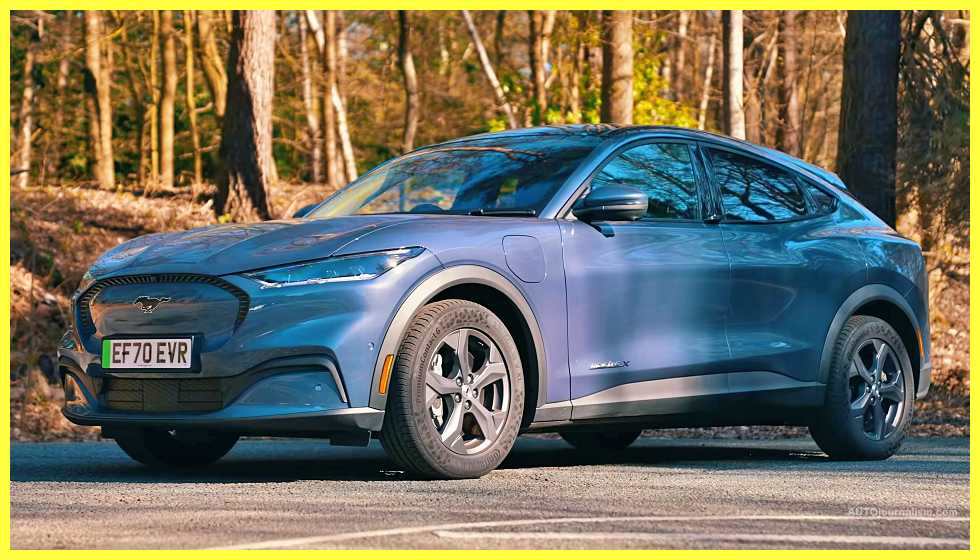
In a world where young people are more ecologically sensitive, the Mustang Mach E might be the company’s latest attempt to capture the next generation of drivers. The rest of the info is Publish in the next article so stay with us and visit this website regularly.
16. PINK COLOR MUSTANG 2017 MODEL – BONUS
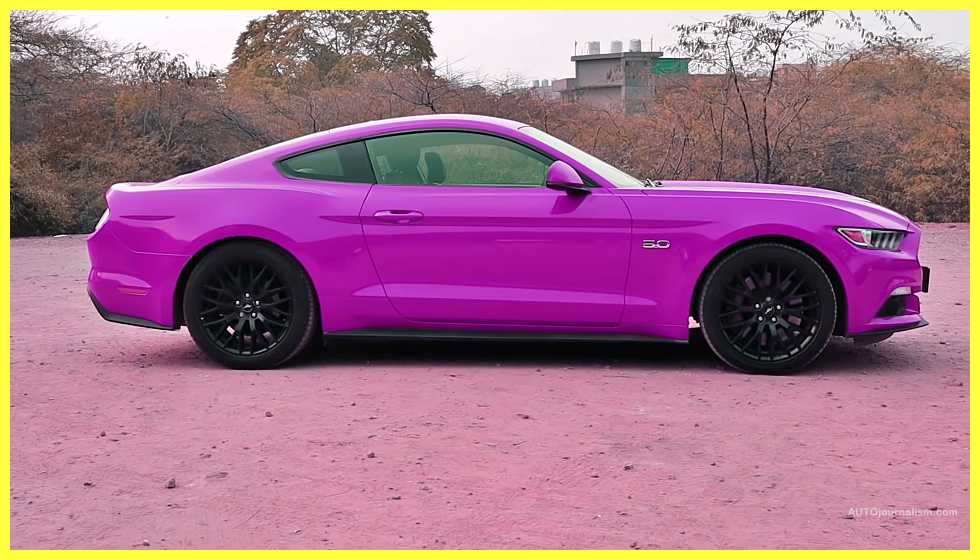
Read also:
Top 10 Best Expedition Vehicles
